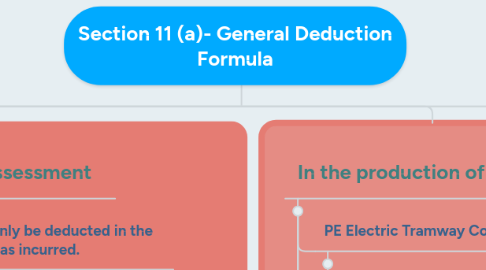
1. In the year of assessment
1.1. An expense can only be deducted in the year in which it was incurred.
1.2. Exception: Prepaid expenditure must be deducted over the period to which the expense relates.
2. Not of a capital nature
2.1. Capital expenditure is NOT deductible.
2.2. Tests have been formulated to test whether it is Capital or Revenue in nature:
2.2.1. Operations vs Structure:
2.2.1.1. Expense is deductible if it adds to the income earning operations and is capital if it adds to the income earning structure.
2.2.2. Fixed vs Floating capital:
2.2.2.1. An expense is capital if it creates an enduring benefit.
2.2.3. What is the true nature of the transaction?
2.2.4. How closely connected is the expense to the income earning operations or structure?
2.2.4.1. Money spent in creating a source of profit is capital- CIR vs George Timber Co
2.2.5. Does the expense relate to fixed capital or floating capital?
2.2.5.1. Floating capital is revenue in nature and therefore deductible- New State Areas case.
2.3. Was the expense "once and for all"?
2.3.1. Recurring expenses are deductible.
3. Actually incurred
3.1. Caltex Oil Ltd vs SIR:
3.1.1. Allowable deductions include amounts that have been paid and liabilities incurred.
3.2. Nasionale Pers BPK vs KBI:
3.2.1. An expense is only deductible when any conditions attached to it have been met.
3.3. Edgars Stores Ltd vs CIR:
3.3.1. An amount is not deductible if it is conditional or subject to a clause or event.
3.4. Port Elizabeth Electric Tramway Co. vs CIR:
3.4.1. As long as the liability to pay an amount has been actually incurred (and not necessarily paid) , the amount will be deductible.
3.5. Ackermans Ltd vs CIR:
3.5.1. Contingent liabilities are not deductible.
4. Expenditure and Losses
4.1. Joffe & Co vs CIR:
4.1.1. Expenditure tends to be voluntary wheras losses tend to be involuntary.
5. In the production of income
5.1. PE Electric Tramway Co vs CIR:
5.1.1. The expense must be closely connected with the income earned in order for it to be a deductible expense.
5.2. Joffe & Co:
5.2.1. Compensation paid is disallowed as a deduction if the negligent action is not a necessary concomitant of trade.
5.3. Sub Nigel Ltd vs CIR:
5.3.1. Expenditure is deductible irrespective of the year in which it produces income.
5.4. CSARS vs BP SA:
5.4.1. The purpose of the expense must be assessed in order to determine whether it was incurred in order to produce income.
5.5. WF Johnstone & Co vs CIR:
5.5.1. Expenditure paid in the current year of assessment for services rendered in prior years of assessment is not deductible.
5.6. CIR VS Nemojim:
5.6.1. Expenditure can be apportioned if it is incurred for two different purposes.
6. Specific Expenses and Losses
6.1. Fines or Bribes:
6.1.1. These are prohibited deductions.
6.2. Theft or Embezzlement:
6.2.1. Only deductible if closely connected to operations.
